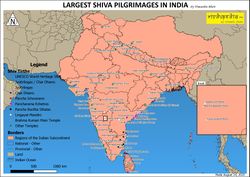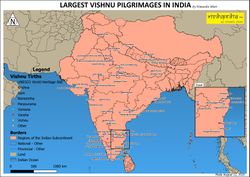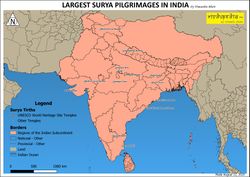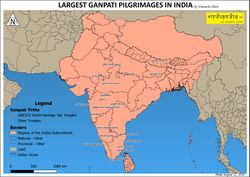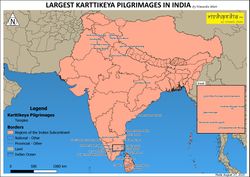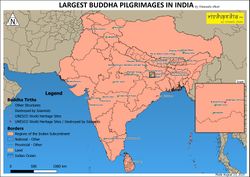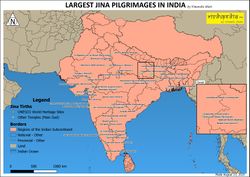Temples
Temples are places of focus for all aspects of life - religious, cultural, educational and social. A temple allows visitors to transcend the world of man and to connect with God.
A temple is a place where you can approach God and realize divine knowledge. Temples are constructed to help aspirants in their journey to enlightenment and liberation. The principles of design and construction and the forms of architecture and decoration were all designed with this principle in mind. All of these are described in detail in the Āgama and the Vāstu Śāstra texts. These texts describe how architecture and decorations should be created to help focus human energy on the Divine. Vastu Shastra has a section explicitly devoted to the design of temples.
Temple are designed to dissolve the boundaries between man and the divine. A temple is not considered to simply be the abode of God, but also is God. God and therefore by implication the whole universe is identified with the temple's design and actual fabric. The ground plan, site location (and its relation to shade and water), its vertical elevation relating to mountains, etc are all important aspects to a temple.
The Puranas state that, "The gods always play where groves are near rivers, mountains and springs". Sacred sites are therefore usually associated with water, shade and lakes are often considered to be sacred and certain lakes have healing and purifying powers. Certain rivers, such as the Ganga, have descended from the heavens and their sacred waters are needed in the temple tank.
Caves are places of great sanctity. Most of the earliest surviving shrines are rock cut caves. In later temples the garbagriha was designed to resemble a cave and as such was small and dark and the surfaces of the walls were unadorned and massive. The garbagṛha is a place that encourages meditation which is possible only in solitude. Approaching the shrine is a movement from open spaces to a confined small space; from light to darkness, from a profusion of visual form and decoration to the visual simplicity of the cave. From this sanctuary the implied movement is vertical, to the symbolic mountain peak directly above the image of the god. This movement upwards is linked to the idea of enlightenment which is identified with the crowning finial of the temple - the amalaka or Śikhara.
The concept of spirituality in the system of sacred architecture in India is something that goes beyond the mere static relations between inert objects and space as found in other architectural traditions. The relationship of objects with one another and space in India's sacred architecture extends to include higher entities said to be in charge of various aspects of universal affairs, all of whom carry out their work in accordance with the will of God.
Temple Finances[edit]
Most ancient stone temples were the result of royal patronage and built to benefit of the whole community, they were expressions of the devotion and piety of the ruler and his people.
The temples were maintained through donations from royal patrons and private individuals. They were given money, gold, silver, livestock and income from grants of land which sometimes included whole villages.
How temples shape and transform energy[edit]
The purpose of all rituals is directed towards reshaping of human psyche, transformation of individual perception into universal perception and radical changes in personal thoughts, desires and ambitions. The space or sky is reshaped in temple architecture through domes, pyramids, various shapes and forms to provide maximum rhythmic response to achieve the desired results.
All religious rituals have a definite aim - transformation of the lower energy formats in the human being into the energy form of the outer spaces, or the sky, or the universal being that is immensity. A suitable medium is provided by the sky as shaped by the domes and pyramids. A deity in the temple is a medium to absorb all the individual desires suitably transformed by rituals. The Deep Mala (fire pillar) in the line of the deity's vision in the outer space of the temple serves as the bridge linking the inner vessel of collective desires represented by the deity with outer space or sky that is universal immensity. This fire pillar has a characteristic shape, which points towards the sky. A divine fire, which is the purifying factor in the temples, is lit using ghee made from cow's milk. Through this fire circulates a rhythmic ascending energy form. Deity's vision is normally aligned to the North or the East directions, which are the sources of Jaivik Urja or positive energies.
Temple Architecture[edit]
Temple architecture represents the concept of evolution and radical changes. The complex energy forms and finer elements are intertwined with deities, trees, plants, colors, shapes and forms in the temple architecture. Different deities in the temple represent body, mind, intellect and the sub-components. These deities are then linked to the cosmos by associating them with specific directions. This philosophy establishes a chain of relationships between micro level elements and the macro level existence. The mandalas available in temples are essentially charts of existence, transformations, and energetic.
Temple Architecture and Prāṇayam[edit]
Pavan or wind is the bridge for the mind to ascend to the sky. The holistic concept of evolution is defined in terms of the medium - 'the wind'. Wind represents both, the Sound and the sky. Therefore, primordial sounds are the keys to reinforcing the bond between the mind and the sky. Controlling the wind element at individual level is called prāṇayam. We can say that the temple architecture provides a natural stage of prāṇayam, not with any definite individual efforts, but through various forms, shapes, rituals and sounds. These parameters establish a unique path for correlating the wind and the sky. Domes and pyramids in the temple transform the sound into the mandalas. The echo of this rhythmic primordial sound takes the wind to the sky. The Gurutatva is described as 'Akhand Mandalakaram'. This means that the rhythmic mandalas created by the echo of primordial sounds activate the gurutatva in the human mind.
In other words, temple architecture creates a space for holistic atmosphere of natural prāṇayam suitable for any individual. Echo of primordial sounds enters the limitless finer circles beyond the audible range and helps the mind to transcend māyā to reach the Absolute.
Temple Design Manuals[edit]
The Agamas and the Vastu Shastra texts are the scriptural authorities on temple architecture. They give precise details and formulas prescribing how to design, carve and assemble a temple. The resulting structure and its relationship with its surroundings create a subtle, sublime atmosphere in which ceremonies performed by priests easily lift the veil between this world and the world of the Gods and Devas so their blessings can pour forth to gathered devotees.
In fact, temple architecture is a specialized subject in Vaastu Shastra. Right from selection of site, to defining the dimensions of the structure, to placement of water source or pond and deep mala, to determining the exact form and proportions of the idol is described in great detail.
Temple Location[edit]
The temple should be built at a suitable place, like a Tirtha. The ideal location is a a beautiful place where rivers flow, on the banks of a lake or by the seashore; on hill tops, mountain slopes, or in a hidden valley. The site of the temple may be selected in a forest, a grove, or in a beautiful garden. Temples should also be built in villages, towns and cities or on an island, surrounded by water.
The temple itself should always face east since that is the most auspicious direction. From the east appears the rising sun, the destroyer of darkness and the giver of life.
Significance of Parikrima[edit]
When in a temple, it is customary to circumambulate the deity.
When a temple is established and life is infused into the deity through a proper prāṇa pratisṭha ceremony, divinity enters the deity. This divinity is in the form of magnetic waves starting from the central point of the base of the deity and spreads around in a circle. The vibrations are the strongest near the deity and gradually weaken as the circle becomes larger. The positive vibrations influence a person walking around the deity.
The magnetic field moves in a clockwise direction, therefore, it is essential that one walks around the deity clockwise. By moving along the magnetic field of the deity one can benefit from the positive vibrations one receives. These vibrations are a blessing that strengthen the worshiper and protect him/her from all kinds of problems and calamities. After completing prayers and offerings, it is therefore customary to walk around the deity. The longer one walks around the deity, the greater the benefit from the vibrations. It is customary to walk 5 to 11 times around a deity.
Religious texts direct that when going around the deity of Shankar one should not cross the line where the offering of milk and water flows. For this reason, one takes only half a round around Shankar. One returns and then does the other half because the vibrations around Lord Shankar move both clockwise and anti-clockwise.
When one walks anti-clockwise, the divine vibrations that move clockwise counter the individual's personal vibrations, gradually destroying them. Therefore, the anti-clockwise movement is prohibited. The harmful effects vary according to the Deity being circumambulated.
Rituals[edit]
There are four kinds of rituals conducted in a temple:
- Nitya - daily
- Naimittika - occasional
- Kāmya - optional
- Prayaschitta - expiation
Related Articles[edit]
More about Temples[edit]
Temples throughout India[edit]
Temples of Andra Pradesh[edit]
Temples of Karnataka[edit]
Temples of West bengal[edit]
- Kalighat Temple
- Dakshineshwar Temple
Temples of Gujarat[edit]
- Somnath Temple
- Dwarkadhish Temple
- Dakor Temple
Temples of Jammu & Kashmir[edit]
- Vaishno devi Temple
- Amarnath
Temples of Tamil Nadu[edit]
- Thiru Aayarpaadi Sri Kari Krishna Perumal
- Pallikondeswara Swamy Surutapalli Devasthanam
- Vasishteswaraswamy Temple
- Sri Naganathaswamy Temple Thirunageshwaram
- Sri Balasubramanya Swamy Temple Ayikudi
- Sri Dharbarenyeswarar Temple Thirunallaru
- Sri Swedaranyeswarar Temple Thiruvengadu
- Sri Kalyanavaradharaja Perumal Temple Paruthiyur
- Karungaali Sri Chinthaamaneesarar
- Thiruverkaadu Sri Karumaari Amman
- Thiruverkaadu Sri Vedhapureeswarar
- Kettavarampalayam Sri Ramar
- Madhuraanthakam Eri Kaatha Sri Raamar
- Vallakkottai Sri Subramanyar
- Thiruninravur Sri Hridhayaaleeswarar
- Thiruninravur Sri Bhakthavatsala Perumal
- Thirumazhisai Sri Othaandeswarar
- Thirusoolam Sri Thirusoolanaadhar
- Singaperumal Koil Sri Ugra Narasimhar
- Chettippunyam Sri Varadharaja Perumal
- Thirukkachur Sri Kachabeswarar
- Thirukkachur Sri Oushadheeswarar
- Hanumanthapuram Sri Agora Veerabadhrar
- Chenganmaal Sri Chenganmaaleeswarar
- Thiru Idaichuram Sri Gnanapureeswarar
- Sembakkam Sri Jambugeswarar
- Cherappanancheri Sri Veemeeswarar
- Thirumalai Vaiyaavoor Sri Prasanna Venkatesa Perumaal
- Ezhuchur Sri Nallinakkeeswarar
- Ariyathurai Sri Varamoortheeswarar
- Thiruvidandhai Sri Nithya Kalyaana Perumaal
- Kolappaakkam Sri Agatheeswarar
- Somangalam Sri Somanaadheeswarar
- Gerugambaakkam Sri Neelakandeswarar
- Porur Sri Ramanaadheswarar
- Kunrathur Sri Naageswarar
- Maangaadu Sri Velleeswarar
- Poondhamalli Sri Vaidheeswarar
- Kovur Sri Sundhareswarar
- Maangaadu Sri Vaikunda Perumaal
- Nandhambakkam Sri Kothandaramar
- Pozhichalur Sri Agatheeswarar
- Aathur Sri Muktheeswarar
- Koyambedu Sri Kurungaaleeswarar
- Semmancheri Sri Srinivasa Perumaal
- Vyasarpadi Sri Raveeswarar
- Pon Vilaindha Kalathur Sri Munkudumeeswarar
- Ponpadhar Koodam Sri Chathurbuja Kothandaraamar
- Manimangalam Sri Dharmeswarar
- Manimangalam Sri Kailaasanaadhar
- Vallam Sri Vedhaantheeswarar and Sri Giri Varadharaaja Perumaal
- Kaaladi Sri Aadhi Sankarar
Temples of Kerala[edit]
Temples outside of India[edit]
USA[edit]
See also[edit]
External Resources[edit]
References[edit]
- The Hindu Temple
- "Secrets of a Hindu Temple"
- "Vastu Shastra and Sacred Architecture" by By Swami B. G. Narasingha
- "Hindu Rites, Rituals, Customs & Traditions" by Prem Bhalla

